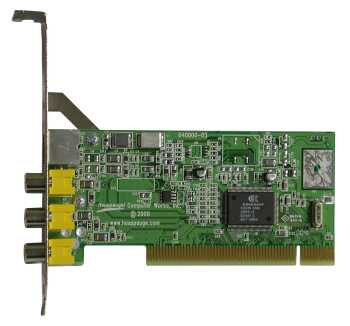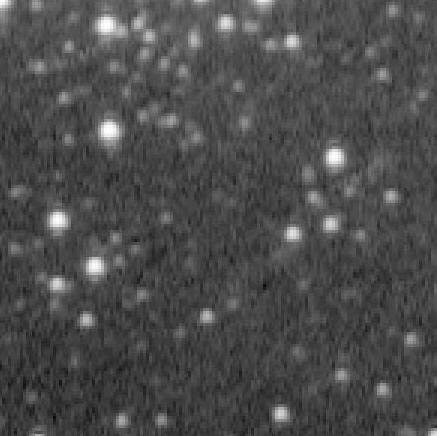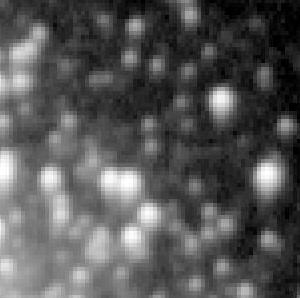 Hauppauge PCI-bus frame grabber
Hauppauge PCI-bus frame grabber
Comparison of different frame grabbers
 Hauppauge PCI-bus frame grabber
Hauppauge PCI-bus frame grabber
|
The Mintron and Watec video cameras output an analog video signal that has to be captured and digitised for further processing with computer programs. Frame grabbers do this job and can be obtained as internal devices for the PCI-bus or as external devices with USB or firewire interfaces. I used for many years a PCI-bus frame grabber made by Hauppauge. The camera at the telescope standing in my backyard was connected to the frame grabber by a 20 metres long video cable. Sitting at the desk in a warm room was very comfortable but the artefacts produced by this frame grabber were annoying. The steep transition from well focused bright stars to the dark background caused the eletronics of the frame grabber to exceed and bounce back in the read-out direction of the CCD sensor. This was not only visible in the images (see example below) but could also be detected at hot pixels which had tails of gray pixels of alternating brightness. |
| |
|
The enlarged detail from the image above shows clearly the arcs left and right of the brighter stars. The read-out direction of the CCD-sensor is parallel to its longer side and parallel to the longer side of the image. Because the shape of the image of a star is a disk the tails are shaped as arcs. The dark intervals between are very characteristic. Here the brightness function has negative values that are set to zero by the electronics. Less brigth stars show only the brightest part of the arcs left and right of the stars. By the way: Bright stars are of 11th magnitude. Extensive tests did reveal that this effect was neither caused by the camera itself nor by the video cable or its length nor by any interferences from nearby electronic devices. Even without the 20 metres long video cable or with an alternative power supply of the camera the effect could not be influenced significantly. All that hinted to the frame grabber as the culprit. Other Watec users reported similar problems. However, not all users. |
|
Then I purchased a frame grabber made by KWORLD model DVD Maker USB2.0 with USB interface (shown left). A quick test under the starry sky revealed that this frame grabber showed nasty artefacts, too. Please note that for the following images the read-out direction is vertical. |
|
 KWORLD DVD Maker USB2.0 without a 20m video cable to the camera
KWORLD DVD Maker USB2.0 without a 20m video cable to the camera
|
|
Then I was told that the frame grabbers made by TheImagingSource did not show such artefacts. However, their products are not cheap. TheImagingSource call their external frame grabbers Converters. The following images show that the artefacts are gone when using the USB frame grabber from TheImagingSource. With a 20 metres video cable (center image) a diffuse tail can be observed. Without such a long cable the stars are round and show no tails. Please note that for the following images the read-out direction is vertical. |
|
 TheImagingSource USB-Converter with a 20m video cable to the camera
TheImagingSource USB-Converter with a 20m video cable to the camera
|
 TheImagingSource USB-Converter without a 20m video cable to the camera
TheImagingSource USB-Converter without a 20m video cable to the camera
|
|
|
When I started to guide my images using an auto guider I noticed stripes in the images produced by the frame grabber from TheIamagingSource. The orientation of the stripes was 90 degrees to the read-out direction of the CCD sensor, i.e. parallel to the shorter side of the image. These stripes could even be observed in the live image if the contrast was adjusted. The difference between the bright and dark stripes is very small but easily visible if the contrast is boosted to show the fainter details of the objects. See the image above as an example. I did not notice this shortcoming in my first tests because then I did not guide and had a small drift parallel to the read-out direction. This smeared the transitions from bright to dark and back and produced a equally bright background. I found no possibility to eliminate these stripes by applying mathematical calculations and had to do all images again. This time by using the "drift method". Well, there is another disadvantage. The new frame grabber works only with a USB2.0 connection and this means that the length of the USB cable is limited to a few feet. So my notebook and I have to stay in the cold again instead of sitting in a warm room. You can't have it all. |